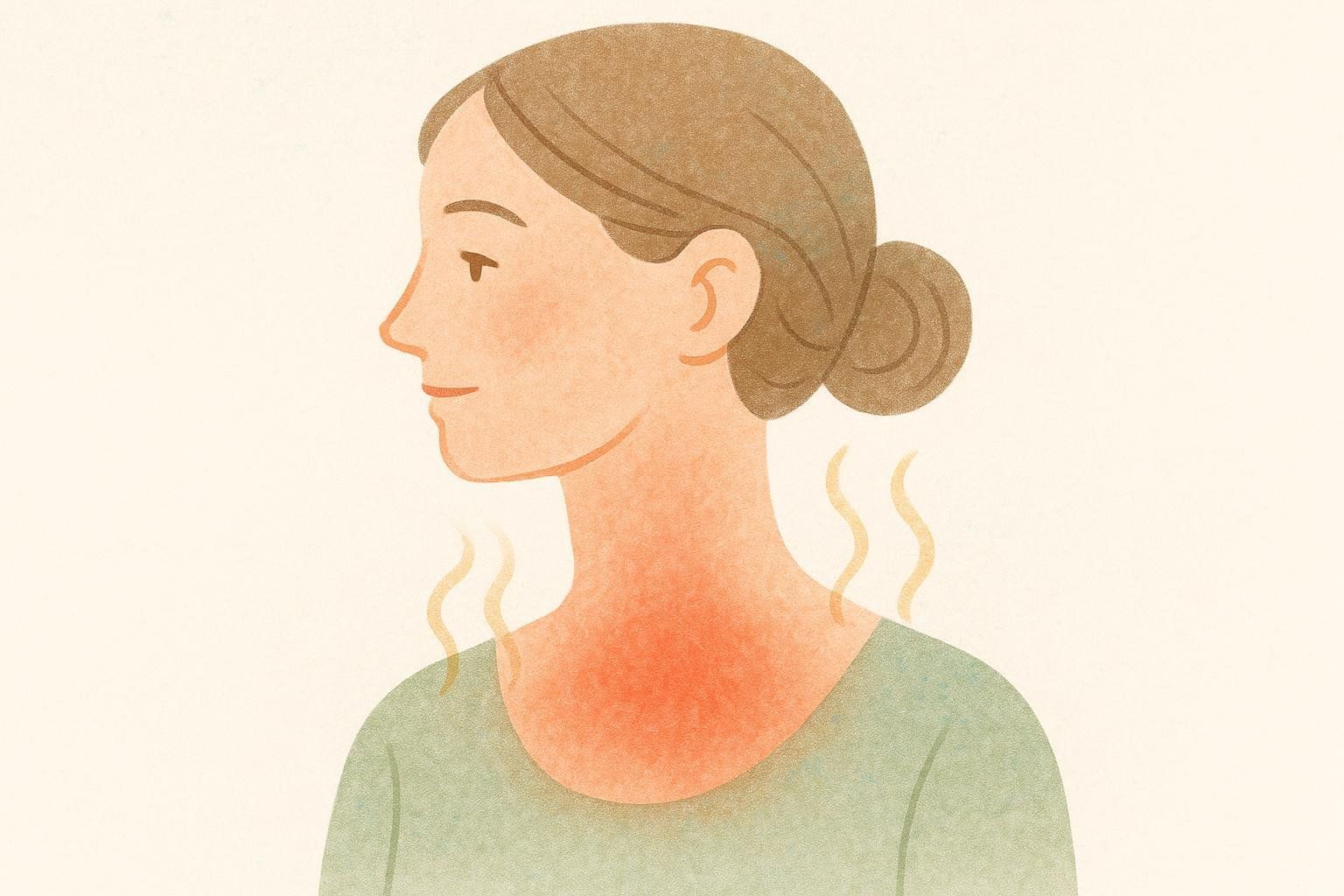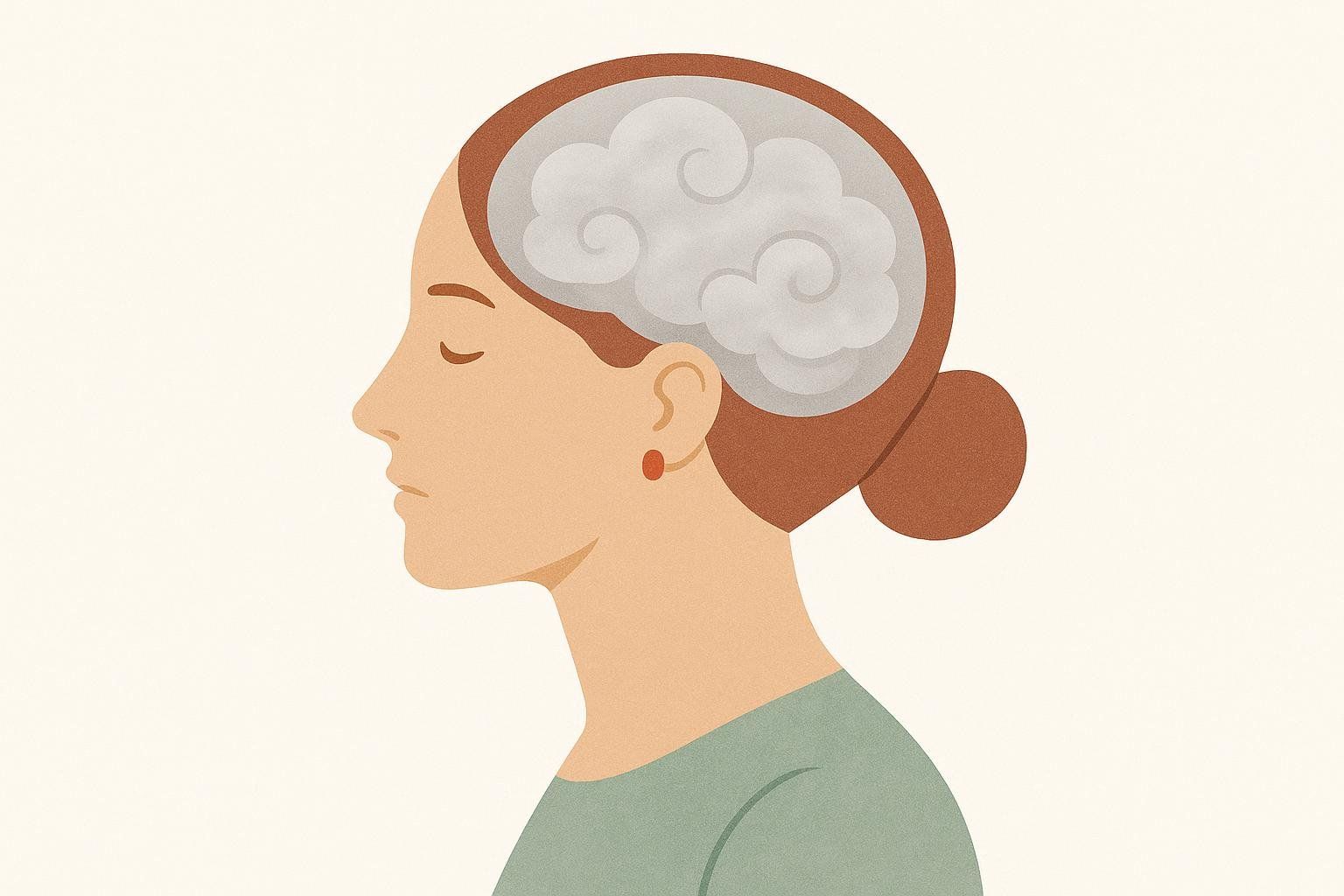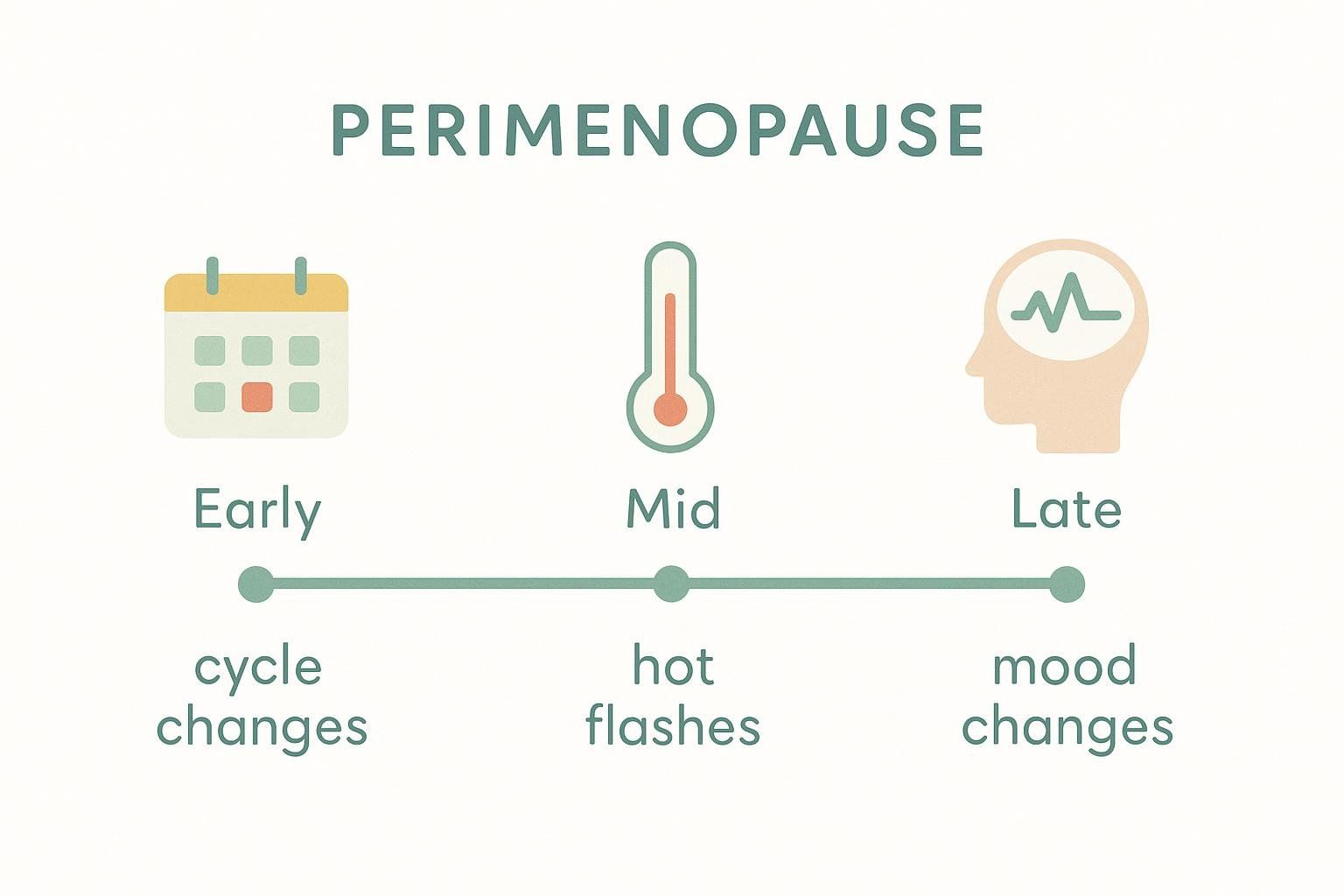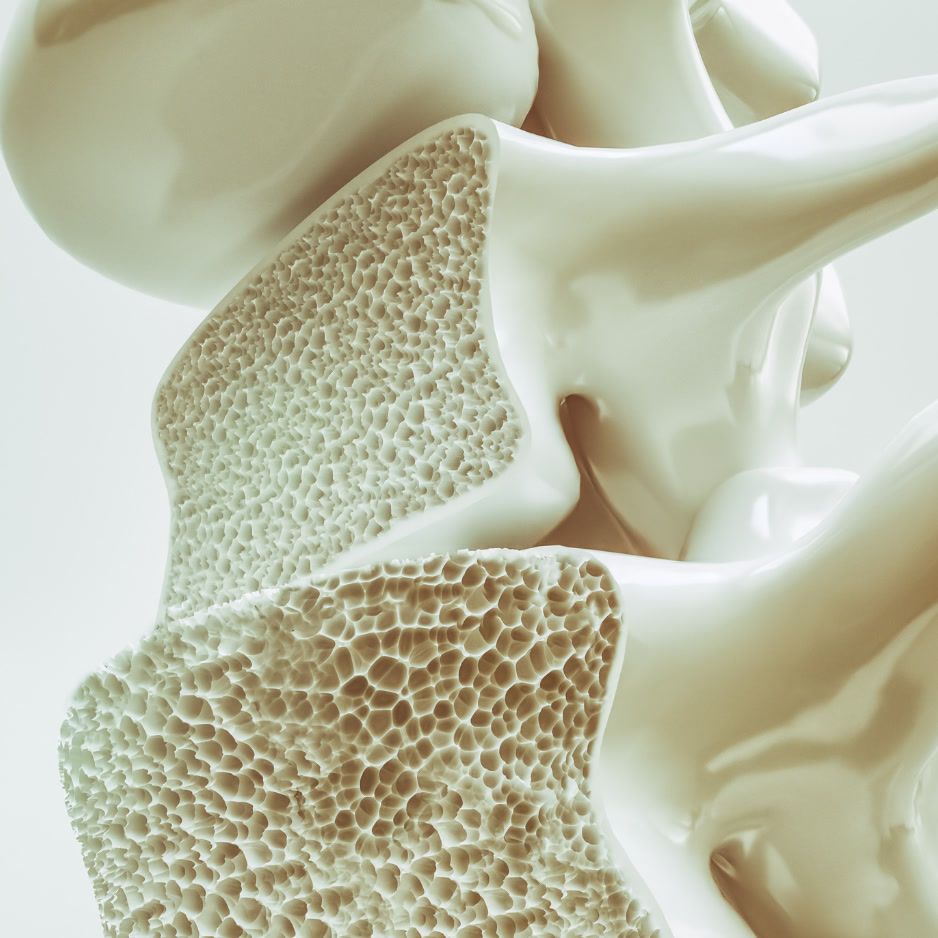Perimenopause Symptoms: Signs, Timeline, and Relief Options

Perimenopause Symptoms: Signs, Timeline & Relief
The quick answer
- Most common symptoms: irregular periods, hot flashes and night sweats, sleep issues, mood changes, brain fog, vaginal dryness/urinary changes, and midsection weight gain (Cleveland Clinic; The Menopause Society). Up to 80% experience hot flashes/night sweats during the transition (The Menopause Society).
- When it starts: often in the 40s, but can begin in the late 30s; the transition typically lasts 4–8 years (Johns Hopkins Medicine; NCBI).
- Fast relief options: cool-sleep strategies, exercise, stress tools, vaginal moisturizers/lubricants, and—if needed—non-hormonal meds or hormone therapy with your clinician’s guidance (Cleveland Clinic; The Menopause Society).
- Important: You can still get pregnant until you’ve gone 12 months without a period—use contraception if pregnancy isn’t desired (The Menopause Society).
1) Vasomotor symptoms (hot flashes and night sweats)

What it feels like: sudden heat surges, flushing, sweating, palpitations; at night, they can drench sleepwear.
- Prevalence: Up to 80% report vasomotor symptoms (VMS) in the transition (The Menopause Society).
- Timeline: Can start in perimenopause and last a median of 7–10 years in some groups (NCBI).

What helps (stepwise options):
- Lifestyle: Keep bedroom ~68°F or cooler, use breathable bedding, identify triggers (alcohol, spicy food, heat), keep regular exercise, and practice stress reduction. Our guide to managing night sweats offers additional lifestyle strategies.
- Non-hormonal medications: Options include SSRIs/SNRIs (such as paroxetine, escitalopram, or venlafaxine), gabapentin (often at bedtime), and oxybutynin. A clinician can weigh risks/benefits and check for interactions; for example, some antidepressants can interfere with tamoxifen, a drug used in breast cancer treatment (Cleveland Clinic).
- New option: Fezolinetant is an NK3-receptor antagonist that reduces hot-flash frequency and severity. It targets the brain’s thermoregulation pathway; treatment may involve liver function monitoring (Cleveland Clinic).
- Hormonal: Menopausal hormone therapy (MHT/HT) is highly effective for moderate–severe VMS in appropriate candidates (The Menopause Society). Our guide to bioidentical hormones explores this topic in greater detail.
2) Cognitive symptoms (brain fog, word-finding, concentration)

What it feels like: trouble retrieving words or names, distractibility, short-term memory lapses.
- How common: Cognitive changes are reported by 40–60% during the transition; they’re usually mild and not dementia (The Menopause Society).
What helps:
- Sleep hygiene and CBT-I if insomnia co-exists; consistent bedtime/wake time, cool dark room.
- Aerobic + resistance exercise for attention and mood (bonus: preserves lean mass). Explore strategies to improve body composition during menopause.
- Stress management: mindfulness/breathing to lower arousal that interferes with working memory.
- Rule out other potential causes: thyroid disorder, anemia, depression, or B12 deficiency—discuss testing with your clinician (Johns Hopkins Medicine).

3) Urogenital symptoms (GSM: vaginal, vulvar, urinary)

What it feels like: vaginal dryness, burning/itching, discomfort with sex, spotting after intercourse; urinary urgency, frequency, or recurrent UTIs.
- Timing: GSM may begin in perimenopause, but for many it becomes more noticeable years after menopause as estrogen drops further (The Menopause Society).
What helps:
- First-line: Regular vaginal moisturizers and lubricants.
- Local therapy: Low-dose vaginal estrogen or DHEA can restore tissue elasticity and reduce UTIs (talk with your clinician). Systemic absorption is minimal with low-dose local products per standard guidance (The Menopause Society).
- Pelvic-floor therapy: Helpful for urinary urgency or stress incontinence; ask for a referral.
4) Metabolic and musculoskeletal symptoms (weight gain, body recomposition, joint aches)
What it feels like: midsection weight gain, increased visceral fat, harder-to-maintain muscle, joint stiffness/aches.
- Why it happens: Fluctuating—then declining—estrogen can alter fat distribution and insulin sensitivity and may reduce resting energy expenditure; muscle mass also trends down without resistance training (Johns Hopkins Medicine; NCBI).
What helps:
- Nutrition: Aim for ~1.0–1.2 g protein/kg body weight daily to support muscle, and get at least 25–30 g of fiber/day for metabolic health. Studies show that higher protein intake helps maintain muscle mass, while adequate daily fiber offers metabolic benefits. For more, see our guide to managing menopause weight gain and our overview of metabolic changes in menopause.
- Training: 2–3 days/week of resistance training + daily walking or low-impact cardio; add short post-meal walks to improve glucose handling.
- Track body composition: DEXA quantifies visceral fat and lean mass so you can tailor nutrition and training with objective data.
- Further options to discuss with your clinician: Consider MHT (if already using for other symptoms) and ask about anti-obesity medications. Evidence-based guidelines support pharmacotherapy for qualifying adults when lifestyle changes alone aren’t enough, as outlined by the Endocrine Society’s obesity guideline. Early studies also suggest HT use may enhance weight-loss response to semaglutide in postmenopausal women (Menopause journal, 2024). Use DEXA with your care team to monitor progress over time.
5) Mood and psychological symptoms

What it feels like: increased emotional lability, worry, or low mood; often tied to poor sleep.
- Risk window: Vulnerability to depression increases during perimenopause and the early postmenopausal years—especially with a prior history of mood disorders (The Menopause Society).
What helps:
- Sleep first: Address insomnia/hot flashes that drive mood changes; CBT-I or treating VMS often improves daytime mood.
- Therapy options: Cognitive behavioral therapy or mindfulness-based stress reduction can reduce symptom burden.
- Medications: SSRIs/SNRIs can treat both mood symptoms and hot flashes in some individuals (Cleveland Clinic).
Lesser-known symptoms you might notice
Beyond the most common signs, estrogen fluctuations can cause other, sometimes surprising, symptoms:
- Heart palpitations
- Dizziness
- Headaches/migraines
- New or worsening allergies
- Skin or hair changes
- Joint and muscle pains
- Breast tenderness
Sources: UCLA Health; Healthdirect
These often reflect the system-wide role of estrogen and can improve with time or targeted treatment. Always discuss new, severe, or persistent symptoms with your clinician to rule out other causes.
Symptom timeline: what shows up when?

While everyone’s experience is unique, patterns commonly unfold like this:
| Stage | What’s happening hormonally | Common symptoms |
|---|---|---|
| Early perimenopause | Estrogen/progesterone fluctuate; cycles shorten or vary by ≥7 days | Heavier/lighter periods, PMS intensification, sleep changes, anxiety/irritability (The Menopause Society). |
| Mid perimenopause | More erratic ovulation; estrogen spikes/dips | Hot flashes/night sweats, brain fog, palpitations, migraines, urogenital dryness (NCBI). |
| Late perimenopause | Longer gaps between periods (≥60 days) | Worsening VMS, sleep disruption, mood changes; metabolic shifts become more obvious (Johns Hopkins Medicine). |
Tip: Hormone labs aren’t usually needed for diagnosis due to day-to-day variability—menstrual history and symptoms are most reliable (Cleveland Clinic). If you’re considering testing, here’s a primer on hormone testing for women.
When to call your clinician (red flags)
Seek prompt medical attention if you have:
- Very heavy bleeding (soaking pads/tampons every 1–2 hours, large clots), bleeding after sex, spotting between periods, cycles <21 days apart, or bleeding longer than usual—these can signal fibroids, polyps, clotting disorders, infection, or, rarely, cancer (Cleveland Clinic).
- Chest pain, persistent palpitations, new severe headaches, neurological symptoms, fainting, or unexplained weight loss.
- Night sweats with fever and swollen lymph nodes.
Pregnancy is still possible in perimenopause—use contraception if you don’t want to conceive (The Menopause Society).
Build your personalized relief plan
Use the quick selector below to match symptoms with proven options. Always review choices with your clinician—especially if you have a personal/family history of breast cancer, blood clots, stroke, liver disease, or are on interacting medications.
| Symptom | First-line steps | Escalation options |
|---|---|---|
| Hot flashes/night sweats | Cool room/bedding, trigger tracking, exercise, stress tools | SSRIs/SNRIs, gabapentin; fezolinetant; MHT for eligible candidates (Cleveland Clinic; The Menopause Society) |
| Insomnia | Consistent sleep schedule, CBT-I, limit alcohol/caffeine, manage VMS | Short-term sleep meds (clinician); treat underlying hot flashes |
| Vaginal dryness/pain with sex | Moisturizers + lubricants | Low-dose vaginal estrogen or DHEA; pelvic-floor PT (The Menopause Society) |
| Midsection weight gain | Protein-forward diet, fiber ≥25 g/day, 2–3×/week strength, daily walking; monitor with DEXA | MHT (if already using), anti-obesity meds (clinician) |
| Mood swings/anxiety | Sleep optimization, CBT/MBSR, exercise | SSRIs/SNRIs as appropriate; address VMS that worsen mood (Cleveland Clinic) |
Tracking body composition changes with DEXA
Hormonal shifts can quietly change body composition months before the scale moves. Learn more about how DEXA works.
Use scans every 6–12 months to validate your plan and track:
- Lean mass by region (are you losing muscle?)
- Visceral fat in grams and percentile (is belly fat rising?)
- Bone-density trends from the scan (non-diagnostic insights to discuss with your clinician)
Get your baseline by booking a BodySpec DEXA scan.
FAQs
-
What are the first signs of perimenopause?
Cycle changes (shorter/longer intervals, heavier/lighter flow) often appear first, followed by sleep disturbance and mood changes; hot flashes may come later (The Menopause Society). See our primer on perimenopause age and timelines. -
How long do symptoms last?
The transition commonly lasts 4�–8 years, but VMS can persist for years in some individuals (NCBI). -
Can perimenopause start in the late 30s?
Yes—less common, but possible. Discuss early symptoms with your clinician, especially with a family history of early menopause or prior chemotherapy (Cleveland Clinic). -
Do I need hormone testing to “prove” perimenopause?
Usually not; levels fluctuate widely. Diagnosis is clinical, based on symptoms and menstrual patterns (Cleveland Clinic). If you’re curious about labs, see our guide to hormone testing for women. -
Does HRT cause weight gain?
Weight change is usually modest and mixed; estrogen may help body-fat distribution in some, a topic we cover in our guide to HRT and weight.
The bottom line
Perimenopause is a normal, navigable life stage. Understanding your symptoms—and pairing smart lifestyle changes with the right medical tools—can dramatically improve quality of life. Use the symptom guide above, consider a BodySpec DEXA baseline, and build a personalized plan with your clinician.
Disclaimer: This article is for educational purposes and is not a substitute for medical advice. Always consult a qualified healthcare professional for diagnosis and treatment.


